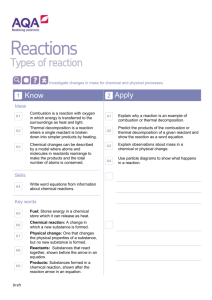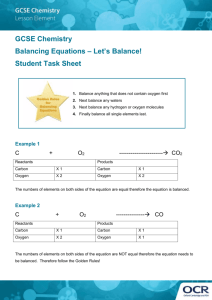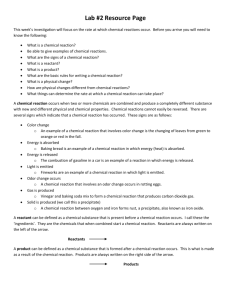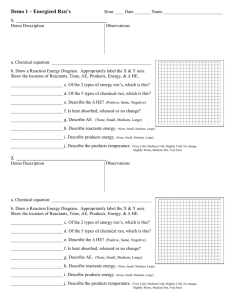ReactionsNotes
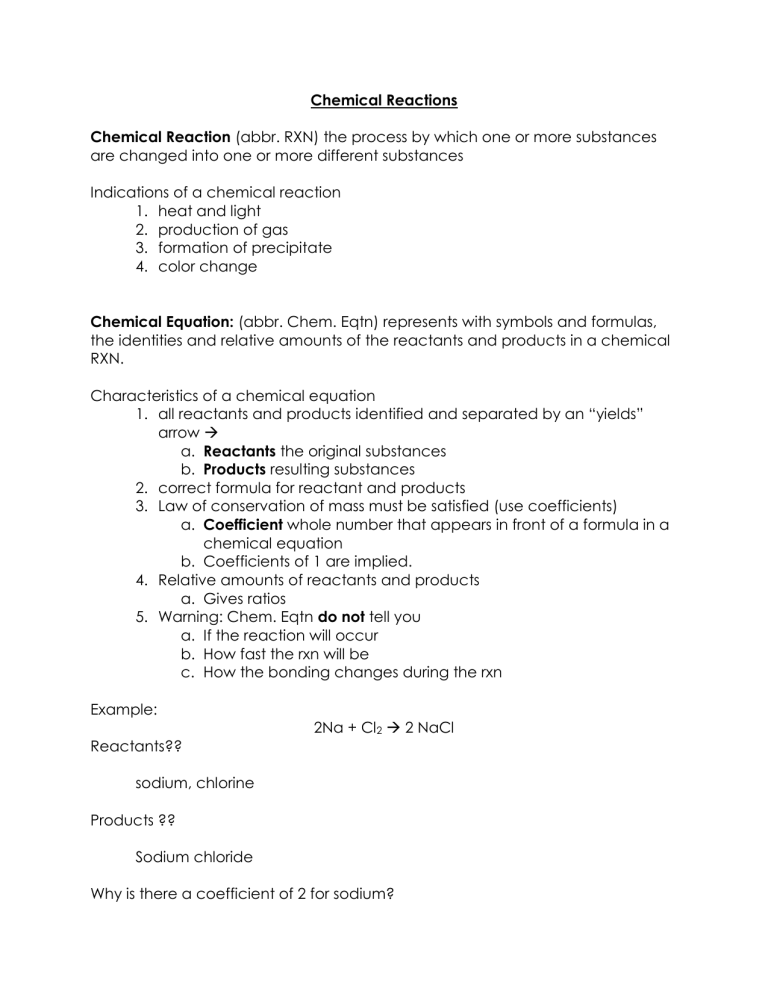
Chemical Reactions
Chemical Reaction (abbr. RXN) the process by which one or more substances are changed into one or more different substances
Indications of a chemical reaction
1.
heat and light
2.
production of gas
3.
formation of precipitate
4.
color change
Chemical Equation: (abbr. Chem. Eqtn) represents with symbols and formulas, the identities and relative amounts of the reactants and products in a chemical
RXN.
Characteristics of a chemical equation
1.
all reactants and products identified and separated by an “yields” arrow a.
Reactants the original substances b.
Products resulting substances
2.
correct formula for reactant and products
3.
Law of conservation of mass must be satisfied (use coefficients) a.
Coefficient whole number that appears in front of a formula in a chemical equation b.
Coefficients of 1 are implied.
4.
Relative amounts of reactants and products a.
Gives ratios
5.
Warning: Chem. Eqtn do not tell you a.
If the reaction will occur b.
How fast the rxn will be c.
How the bonding changes during the rxn
Example:
2Na + Cl
2
2 NaCl
Reactants?? sodium, chlorine
Products ??
Sodium chloride
Why is there a coefficient of 2 for sodium?
Because Chlorine is diatomic, it always has two atoms. If there are two atoms of chlorine than we need two atoms of Sodium.
Coefficient represents number of moles and gives the relative
amounts of reactants and products o Ex. For 1 mole of Chlorine gas, you need 2 moles of Sodium atoms
Balancing equations can be tricky so let’s see another way… http://www.wfu.edu/~ylwong/balanceeq/combust.html
same number of atoms of each element on both sides of the equation
Write down all the elements involved in the equation underneath the reactant side and the product side
From Words to Symbols
Other Symbols used in Chemical Equations
1.
State of mater: placed to the right of the formula a.
(s) = solid b.
(l) = liquid c.
(g) = gas d.
(aq) = aqueous (dissolved in water)
2.
Reaction conditions (table 7.3 in book) a.
Heat added b.
Pressure c.
Temperature d.
Type of catalyst used
Example 1: o Ammonium dichromate yields the products nitrogen gas, solid chromium (III) oxide and water vapor. o (NH
3
(s) +4H
2
O(g)
4
)
2
Cr
2
O
7
(s) N
2
(g) + Cr
2
O
Here’s how to go from Word to Symbol:
Example 2: o When methane burns in air, it combines with oxygen to produce carbon dioxide and water.
1.
Identify the reactants and write them down with a + sign between them and a “yields” arrow after
Methane + oxygen
2.
Identify the products and writhe them down to left of arrow
Methane + oxygen Carbon dioxide + water
3.
Translate words to formulas
CH
4
+ O
2
CO
2
+ H
2
O
4.
Balance the equation
CH
4
+ 2O
2
CO
2
+ 2H
2
O
5.
Add all additional symbols possible to indicate RXN conditions
CH
4
(g) + 2O
2
g) CO
2
(g) + 2H
2
O(g)
*Methane, oxygen, and carbon dioxide are usually gases
*Water is usually liquid or gas. Here it is most likely gas because the temperature of a methane flame is pretty high
From Symbols to Words
Example 3: o 2 ZnO (s) + C(s) 2 Zn(s) + CO2(g)
1.
Write names of reactants and state of matter
Zinc Oxide, solid
Carbon, solid
2.
Write names of products and state of matter
Zinc, solid
Carbon Dioxide, gas
3.
Use pattern to write word equation
Pattern:
[state of matter] [reactant 1] and [state of matter] [reactant 2] react [rxn conditions] to yield
[state of matter] [product 1] and [state of matter] [product 2]
** Pattern is not limited to two reactants and two products, just adjust pattern to fit reaction solid ZincOxide and solidcarbon react to yield solid zinc and gaseous carbon dioxide
Answer: o Solid zinc oxide and solid carbon react to yield solid zinc and carbon dioxide gas. o ** notice that you can write either gaseous carbon dioxide or carbon dioxide gas. o Why isn’t it necessary to say what the coefficients are in the word equation?
Silver Nitrate and Sodium Hydroxide
Sodium Iodide with Mercury (II) Chloride
Reaction of Magnesium with CO
2
MgO + C(s)







